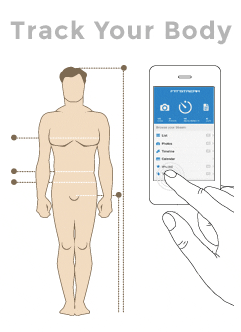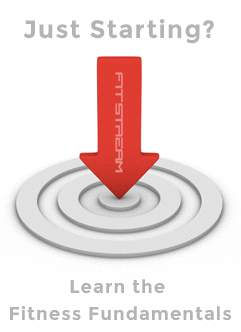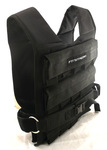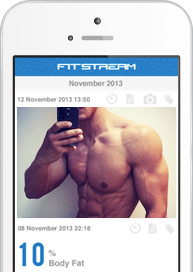Heavy duty fitness resistance bands are an excellent training accessory for both adding intensity to workouts or giving assistance to exercises that you aren't yet strong enough to perform.
Resistance bands have been gaining in popularity as a result of their low cost and the extremely flexible ways that they can feature in your workouts, from weight training, gymnastics ring strength training, bodyweight exercise assistance, to ballistic running drills.
What are resistance bands?

First invented in 1980 by former football coach Dick Hartzell, resistance bands may also be referred to as fitness bands, sports bands or strength bands.
The bands we're referring to are heavy duty resistance bands and not Therabands or the various other forms of elastic fitness product generally marketed at women or for stretching, physical therapy or rehabilitation. These bands are used for intense, serious strength training, powerlifting and general conditioning.
These resistance bands are essentially heavy duty latex elastics formed into a loop that offer various levels of resistance levels based on the thickness of the band. The bands are generally used to make exercises more difficult by adding increasing resistance to exercises as they are stretched, or to make exercises more achievable by supporting part of your bodyweight. The bands offer variable / progressive resistance meaning that the resistance increases throughout the range of motion, with the greatest resistance felt at the top of the lift or stretch.
How are resistance bands used?
Resistance bands can be used in all manner of creative ways across many different training methods. You're truly limited only by your imagination.
Here are some of the ways we've seen heavy duty bands used:
- General fitness and conditioning
- Weight training, powerlifting, weightlifting
- Speed and agility training
- Plyometrics / Jumping
- Aerobics
- Stretching and flexibility exercises
- Rehabilitation and prehabilitation
Weight training \ powerlifting \ weightlifting with resistance bands
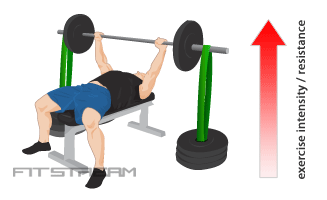
Resistance bands are an effective way of introducing progressive resistance to standard weight training exercises. That is, the further the bands are stretched the more resistance is added to the movement, typically to the parts of the exercise that are easiest to perform.
Resistance bands can be used in various ways to help with common weight training exercises like the squat, deadlift or bench press by securing the band to an anchor point (like a heavy dumbbell / weight plate / power cage frame) and the other end to either side of your barbell.
Note: Ensure that you use a heavy dumbbell or weight plate so that they won't raise from the floor during the lift, or thread the bands through additional weight plates to secure. If round dumbbells are used you may need to fix these in position with other plates to prevent them rolling around.
To increase the resistance simply loop the bands round the anchor point a few times before choking. This technique will increase tension throughout the lift and ensure that you develop explosive power, speed, strength and increase acceleration with gains in absolute strength.

Bodyweight exercises using resistance bands (assistance and intensity exercises)
We've selected a few common bodyweight exercises below to illustrate how resistance bands can be used to help develop the necessary strength and coordination to perform the exercises unaided.
Assisted pull-up with resistance bands
Pull-ups are a very popular and effective exercise but can be very difficult to the beginner due to the upper-body strength demands.
Whether performing pull-ups on gymnastic rings or a fixed bar, if you aren't quite strong enough for the exercise a resistance band can be used to take some of your bodyweight and make the exercise more achievable. You will quickly develop the required strength to perform pull-ups without the need for the band.
To use bands for an assisted pull-up simply 'choke' the band around the pull-up bar or rings and loop the opposite end of the band under your shoe or secured under one knee.

Grasp the pull-up bar or rings and perform the pull-up as normal and the bands will partly carry your bodyweight to make the exercise easier. As your pull-up strength increases your need for the band assistance decreases.
To control the amount of assistance simply loop the band around the bar a few times before choking. The shorter the band is, the more bodyweight the band will support.
Dips exercise with resistance bands (Video)
Dips are another example of a highly effective bodyweight exercise that are difficult for beginners to achieve.
The video below demonstrates the dip exercise on a fixed dipping platform. During the video you will see resistance bands being used to not only make dips easier but also to increase the difficulty of the exercise by wrapping the band over the shoulders.
Band assisted handstand
The handstand is an impressive exercise that demonstrates agility, coordination, strength and bodily control. Resistance bands can be used to help give you that extra bit stability to allow you to learn the exercise and progress up to a stable handstand hold.

Ballistic running drills with resistance bands
Resistance bands can be used for ballistic running drills to develop explosive power, speed and agility by fixing bands to an anchor point such as a pole or another training partner.
The medium and large resistance bands are recommended for running drills and it's essential that you use at least three bands to ensure that there's a safe operating distance between you and the anchor point!
Link bands using the 'choke' technique described above and secure to your body.
Ring training with resistance bands
Similar to the bodyweight exercises previously discussed, resistance bands can also be used in your ring strength workouts for assistance-based exercises or for adding additional tension and intensity.
Ring training can be very difficult and resistance bands give you that extra help to build up the requisite strength. Attach the bands to your gymnastics rings using the choke technique described below.
The bands can be used for standard ring exercises such as the ring pull-up, or ring dips and for advanced moves such as the iron cross (pictured below) -


How do I attach resistance bands to an anchor point?
You can suspend bands from any anchor point that is solid with no sharp edges, such as:
- Goal posts
- Weight plates
- Basketball poles
- Exercise equipment (dipping station, power cages, benches, tradmills or Squat racks)
- Pull-up bar
- Gymnastic rings (see photo below)
- Another teammate or training partner
- Pipes
- Playground equipment
- Trees
The choke technique:
Attach resistance bands to an anchor point using the choke technique described below.
- Loop the band over / through the anchor point.
- Take one of the looped ends and feed it through the other.
- Pull the band tightly to secure in place.
- The band is now choked and ready to use.
- You can use the above technique to link multiple bands together.
- To add add additional resistance simply loop the band around the anchor point a few times before securing it with the choke technique. This will shorten the band and increase the resistance level.
To buy resistance bands please see the Fitstream Store.

